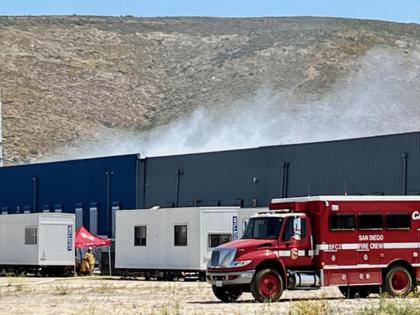EPA announces settlement on cleanup of Otay Mesa battery fire
Published in News & Features
The U.S. Environmental Protection Agency on Monday announced a settlement with Gateway Energy Storage, LLC — the company that operates a battery facility in Otay Mesa where a stubborn fire smoldered for two weeks in May 2024.
The EPA said it will require comprehensive safety measures and monitoring “to protect nearby residents and workers” during the cleanup process that is still underway.
The agency ordered Gateway Energy Storage to conduct environmental monitoring whenever the company handles batteries; safely remove, package and dispose of all impacted battery packs; and submit detailed work plans and progress reports to the agency.
“I am alarmed by the incidents and impacts of utility grade battery fires on first responders, specifically the professional firefighters who are exposed to horrible toxic conditions when batteries catch fire,” EPA Pacific Southwest Region Administrator Josh F.W. Cook said in a statement.
EPA did not issue any financial penalties on Gateway, which is owned by New York City-based REV Renewables that operates renewable energy facilities in 19 states.
A spokesman for REV Renewables told the Union-Tribune in an email that the agreement announced Monday “has been governing our work for the last several months and is not new.”
The spokesman said “a thorough testing” of all the batteries at the facility was completed earlier this year and “a subset” are back in service, “while other work at the location continues.”
The company anticipates cleanup efforts to wrap up at the end of August, but the target may be adjusted as needed to ensure safety.
“We are grateful for the hard work, support and partnership of the EPA, our first responders and local officials, as well as the patience from the greater Otay Mesa community,” the email said.
The blaze broke out on May 15, 2024, in Building 3 of the 250-megawatt facility. The fire appeared to be extinguished but the lithium-ion batteries, with nickel manganese cobalt chemistries, kept reigniting.
Flare-ups continued until May 28, according to EPA officials, keeping firefighters and air monitoring crews from San Diego Fire and the Sheriff’s department at the ready. No injuries or damage to nearby properties were reported.
The root cause of the fire remains under investigation and EPA said Monday it will continue to oversee cleanup efforts, along with local agencies.
“This settlement action is a step in the right direction, but the broader battery storage fire issue requires additional attention and EPA enforcement,” said Cook, a Chico resident who was appointed in March by President Donald Trump.
Battery storage facilities have grown in popularity — particularly in California — as a way to bring renewable energy onto a power system. They are considered a key piece of the Golden State’s target to derive 100% of its electricity from carbon-free sources by 2045 or earlier.
Commonly stacked in rows, batteries typically take electricity that’s generated during the daytime hours from solar, store that energy and send it to the grid in the evening.
Electricity from batteries emit no CO2 and offset power that would otherwise be supplied by fossil fuel generation such as natural gas, while also enhancing grid reliability during those hours.
In May, Gov. Gavin Newsom heralded a nearly 2,000% increase in California energy storage during his administration that included 15,763 megawatts of capacity coming from batteries.
“California is adding battery storage at a pace never seen before as we continue our work to build the grid of the future,” Newsom said.
But a spate of fires have raised questions.
In September 2024, a blaze at a 30-megawatt San Diego Gas & Electric battery facility in Escondido led to the temporary evacuation of about 500 nearby businesses. Crews from the city of Escondido found no abnormal readings indicating toxic fumes and air-quality monitoring did not indicate any health risks.
And in January of this year, a fire broke out at a 750-megawatt facility containing 99,000 LG battery modules in the Northern California community of Moss Landing that led to the evacuation of about 1,500 residents. It burned for two days and closed a section of Highway 1 for three days. Monitoring by the Environmental Protection Agency for hydrogen fluoride and particulate matter showed no risk to public health throughout the incident.
“Calling a technology ‘green energy’ does not mean there are no environmental impacts,” Cook said. “This is an issue of growing concern.”
Supporters counter that battery facility fires are relatively rare and say better safety standards, technological improvements and the development of fire-resistant chemistries will ensure the industry’s growth.
Last month, a survey conducted by Probolsky Research and funded by Cleantech San Diego touted that 65.7% of residents support battery storage projects in San Diego County and 57% support battery storage projects in their own neighborhoods.
_____
©2025 The San Diego Union-Tribune. Visit sandiegouniontribune.com. Distributed by Tribune Content Agency, LLC.







Comments